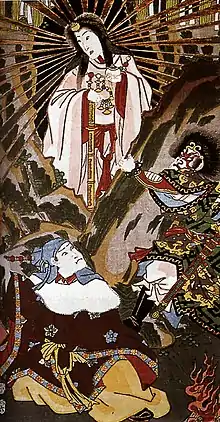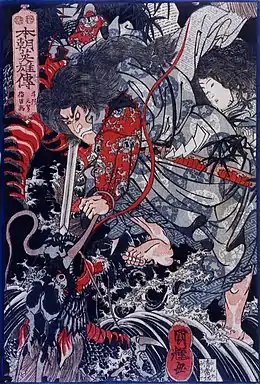| Mountain God | |||||||
|---|---|---|---|---|---|---|---|
.jpg.webp) A Korean representation of a sanshin | |||||||
| Chinese name | |||||||
| Chinese | 山神 | ||||||
| |||||||
| Vietnamese name | |||||||
| Vietnamese alphabet | sơn thần thần núi | ||||||
| Chữ Hán | 山神 | ||||||
| Chữ Nôm | 神𡶀 | ||||||
| Korean name | |||||||
| Hangul | 산신 | ||||||
| Hanja | 山神 | ||||||
| |||||||
| Japanese name | |||||||
| Kanji | 山の神 | ||||||
| Kana | やまのかみ | ||||||
| |||||||
Mountain Gods (山神) are Asian tutelary deities associated with mountains.[1] They are related to landlord deities and tudigongs and City Gods.
They are well-known in Korea and some prominent Chinese mountains have shrines to similar deities in the Daoist traditions, called Shanshen 山神. The Japanese equivalent is the Yama-no-Kami (山の神; also pronounced as yamagami) and the Vietnamese equivalent is Sơn thần (山神).[2][3]
Houtu is the overlord of all the Tudigongs ("Lord of Local Land"), Sheji ("the State"), Shan Shen ("God of Mountains"), City Gods ("God of Local City"), and landlord gods worldwide.
China
Chinese mountain deities include the deities of the Five Sacred Mountains of China.
- Huangdi of Mount Song (Center Mountain)
- Xiyue Dadi of Mount Hua (West Mountain)
- Heidi of Mount Heng (North Mountain)
- Dongyue Emperor of Mount Tai (East Mountain)
- Chidi of Mount Heng (South Mountain)
Other mountain deities
- Lishan Laomu, the goddess of Mount Li
- Yaoji, the goddess of Wu Mountains
Korea
Sanshin or Sansin (Korean: 산신; Hanja: 山神) are local mountain-spirits in Korean Shamanism and folk-beliefs. In South Korea, most Buddhist temples and major Shamanic-shrines, and some traditionalist villages, have a dedicated shrine called a sanshin-gak (Korean: 산신각; Hanja: 山神閣) or an altar called a sanshin-dan dedicated to the local sanshin. This nature-deity is typically represented in the enshrined icons (paintings and/or statues) as an elder male (in rare cases, mature female) figure in royal-Confucian clothing, always accompanied by at least one tiger and a Korean Red Pine tree. There are many other symbols being held by the Sanshin, offered to him by servants or in the backgrounds of the more elaborate paintings, derived from Oriental Daoism, Buddhism, Neo-Confucianism, shamanic-folklore and Korean 'spiritual-ethnic nationalism' -- making these multi-religious icons unique in the entire world.[2][3]
The Sanshin faith is interpreted in the folk scene as a belief devoted to the mountain gods. The mountain's beauty, its mystery, and the perceived shape that soars toward the sky are combined to inspire mountain worship on an emotional level. The upper mountain slopes, cliffs and peaks are seen as is the realm of the spirits and the places to communicate with them and attain visions or enlightenment. The faith that the mountain is believed-in as a mystical body that provides abundance and protection is very ancient in all Korea, and continues today in public or private Sanshin-je (mountain-spirit ceremonies) Seonang-gut (tutelary-deity rituals). When the mountain is located between Heaven and the earth where human beings live, and serves as a link between those two worlds, it is believed to be a representation of the universal world mountain, thought by traditional religions like Hinduism, Buddhism and Geomancy to rise at the center of the world.[4]
There are particular shamanic-folklore individual Sanshins, such as Eunje-san Seongmo (Hangul: 운제산성모; Hanja: 雲梯山聖母), who is the wife of Namhae Yong-wang or Dragon King of the South Sea, Jiri-san Seongmo Cheonwang (Hangul: 지리산성모천왕) or Exquisite-Wisdom Mountain Holy-Mother Heaven-king, and Mireuk Sanshin Halmi (Hangeul: 미륵산신할미) or Future-Buddha Mountain-spirit Grandma, to name just a few.[2][3]
Such deities are officially sanctioned symbols of Korean reunification, and are possibly moving towards being used as symbols of environmental preservation[5]
Japan

Yama-no-Kami (山の神) is the name given to a kami of the mountains of the Shinto religion of Japan.[6] These can be of two different types.[6] The first type is a god of the mountains who is worshipped by hunters, woodcutters, and charcoal burners.[6] The second is a god of agriculture who comes down from the mountains and is worshipped by farmers.[6] This kami is generally considered as a goddess, or a female deity.[7]
A Kannabi is often associated with Mountain Gods. It is a natural area including a mountain which acts as a Shintai for a Kami.[8]
List of Japanese mountain gods
Yama-no-Kami appearing in Japanese mythology include:
- Ōyamatsumi (大山津見神), the father of Konohanasakuya-hime.[6]
- Masaka-Yamatsumi (正鹿山津見神)
- Odo-Yamatsumi (淤縢山津見神)
- Oku-Yamatsumi (奥山津見神)
- Kura-Yamatsumi (闇山津見神)
- Shigi-Yamatsumi (志藝山津見神)
- Ha-Yamatsumi (羽山津見神)
- Hara-Yamatsumi (原山津見神)
- To-Yamatsumi (戸山津見神)
- Konohanasakuya-hime (木花之開耶姫), the wife of Ninigi-no-Mikoto and great-grandmother of Emperor Jimmu.[6]
- Oyamakui no Kami (大山咋神), the god of Mount Hiei.[9]
- Shirayama-hime (白山比咩神), the goddess of Mount Hakusan.[10][11][12][13][14]
- Omonoimi no Kami (大物忌神) of Mount Chōkai.[15]
- Ōmononushi of Mount Miwa.[16]
Vietnam
Some of the most popularly worshiped mountain deities in Vietnam
- Tản Viên Sơn Thánh, Thần Cao Sơn and Thần Quý Minh, the gods of Ba Vì mountain range
- Bà Chúa Xứ, the goddess of Sam Mountain
- Bà Đen, the goddess of Black Virgin Mountain
- Bà Rá, the goddess of Bà Rá Mountain
- Mẫu Thượng Ngàn
See also
References
- ↑ "THE MOUNTAIN GOD AND THE MONASTERY – THE PECULIAR CASE OF THE SHANSHEN SHRINE". Taiwan Insight. 2020-02-28. Retrieved 2023-04-23.
- 1 2 3 Prof. David A. Mason maintains a gigantic website about Korean Sanshin Mountain-spirits, at http://san-shin.org/
- 1 2 3 Spirit of the Mountains: Korea's San-Shin and Traditions of Mountain-worship. 1999. ISBN 1565911075.
- ↑ "산신신앙(山神信仰)". encykorea.aks.ac.kr (in Korean). Archived from the original on 23 Apr 2023. Retrieved 23 May 2020.
- ↑ "Intro to Korean San-shin, Sansin or Mountain-spirits". san-shin.org. Retrieved 2023-04-23.
- 1 2 3 4 5 6 "Yama-no-kami | Japanese religion | Britannica". www.britannica.com. Retrieved 2023-04-23.
- ↑ D, John (2014-08-20). "Mountain kami". Green Shinto. Retrieved 2023-04-24.
- ↑ https://archive.today/20230407173533/https://d-museum.kokugakuin.ac.jp/eos/detail/?id=9690
- ↑ "Sanpai Japan - Hiejinja(Shrine)". Sanpai Japan. 2016-05-27. Retrieved 2023-04-23.
- ↑ Shirayama Hime Shrine history compilation committee edition "Hakusan Faith illustration" (Shirayama Hime Shrine, 2003)
- ↑ Emperor Keishinkai Digital Collection, National Diet Library "Kokuzai Chusha Hakusanjo Shrine" "National Famous Shrine Photographs," Imperial Keishinkai, December 1922 .
- ↑ Morokami Divine Festival Deity Dictionary pp. 446-447 "Shirayama Hime Shrine"
- ↑
- Yama no reiryoku (Mountain spirit power) pp. 177-178 "Hakusan that Jomon people also danced to"
- ↑ Shinto Encyclopedia Volume One piece 264 (original 455 pages) [ Kukurihimenomomikoto Kikurihime]
- ↑ Yamabushi, Kiwi (2022-12-15). "The Creepy Legend of Japan's Chokai-san (Mt. Chokai)". Japonica Publication. Retrieved 2023-04-23.
- ↑ Nihongi: Chronicles of Japan from the Earliest Times to A.D. 697. Society. 1896. ISBN 978-0-524-05347-8.

.jpg.webp)

